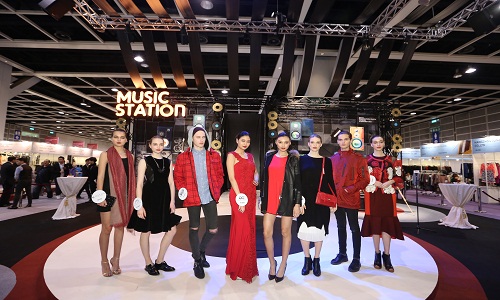FW
Free trade agreements are expected to help bring foreign direct investment into Vietnam. Firms with FDI have an advantage in low cost price, competitive selling price and stable material source. Most Vietnamese companies do not have these advantages. The biggest difficulty they face is a shortage of raw material, putting them in possibly severe competition in material origin rules as per FTA commitments.
Most FDI backed companies in garments and textiles follow closed production process from materials to finished products, design and distribution. Local firms must improve themselves in both business thought and ways. Authorised agencies need to work with associations to issue policies encouraging enterprises to transfer from processing into export under free on board term, original design manufacturers or original brand manufacturers.
Vietnam should have a high determination to develop into a fashion hub of Southeast Asia in future, feel experts. There should be policies to promote equipment manufacturing for the support industry, including those in fiber production lines, dyeing, and chemicals for wastewater treatment. There should be a basis for local firms to exploit opportunities and tax incentives. These policies will work to reduce cost price of support products. Customs and tax procedures should be reformed.
Indians in the US have objected to T-shirts and tank tops made by Print Syndicate which feature images of Hindu gods. They say, Lord Ganesha is revered in Hinduism and is meant to be worshipped in temples or home shrines and not to be trivialised on consumer products. They want the Ohio-based brand to withdraw these products and offer a formal apology. They say Hindus are all for free artistic expression and speech as much as anybody else but that faith is something sacred and attempts at trivialising it would hurt its followers.
Print Syndicate claims to offer consumers access to timely, curated, well-designed and high-quality products that allow them to express who they are. It says it adheres to values like integrity, compassion and fairness. Its products (apparel, phone cases, house wares, etc.) are sold through the company’s six e-commerce brands.
In Hinduism, Lord Ganesha is worshipped as the god of wisdom and the remover of obstacles and is invoked before the beginning of any major undertaking. There are about three million Hindus in the US. Hinduism is the oldest and the third largest religion of the world with about a billion adherents.
Australia’s wool production is forecasted to fall by seven per cent. The decline comes following six season of relatively stable wool production. Seasonal conditions in a number of major sheep producing regions of Australia have been drier than expected, which has resulted in lower fleece weights.
The major sheep regions of Queensland continue to see tough conditions and the sell-off of sheep continues in the state. Even in New South Wales, there are areas where seasonal conditions have been more difficult than expected. Tough conditions are being partially offset by good to very good conditions in north-eastern South Australia and parts of New South Wales.
For the 2015-16 season to November, tests show a reduction in volumes of wool between 20.6 and 24.5 microns, with smaller declines for finer merino wool and for crossbred wool. This resulted in a 0.1 micron decline in the mean fiber diameter for Australia to November.
There has been a release of on-farm stocks held over from previous seasons as well as the forward offering of wool held in brokers’ stores and earlier than usual deliveries of recently shorn wool in response to the spike in wool prices in May and June. But these stocks may not be available in 2015/’16.
Gap is committed to cutting its absolute greenhouse gas emissions. The company plans to halve emissions at its stores, offices and distribution facilities around the world from 2015 levels by the end of 2020, after successfully reducing them by 38 per cent from 2008 levels as of the end of 2015.
Much of the reductions so far have come from installing long-lasting, more efficient LED lighting and smart thermostats at stores, turning off unnecessary lights at night and using an industry shipment program to improve fuel efficiency. Shuttering stores has also contributed, but to a lesser extent.
Gap’s commitment only extends to facilities it owns or operates, and therefore the factories that produce its clothes but not the third-party factories that produce its clothes. The retailer will also try to divert 80 per cent of the waste from its US facilities away from landfills by 2020. In 2014, it diverted just 29 per cent of that waste.
The fashion industry hasn’t been kind on the planet. Toxic chemicals are used to make some clothes, lots of wasted and polluted water and the mountains of apparel tossed into landfills every year. And huge amounts of energy are expended along the life of a garment, from manufacturing to transportation to a sales floor.
www.gap.com/
Textile firms in the US are willing to support the Trans Pacific Partnership. They feel the deal meets their key objectives. Under the negotiated terms Vietnamese cut-and-sew operations in most cases would have to buy yarn and fabric from the United States or other countries within the 12-nation free-trade zone the agreement would create. Currently, Vietnam gets most of its yarn and fabric from China, which is not included in TPP.
The 11 Pacific Rim countries are Australia, Brunei, Canada, Chile, Japan, Malaysia, Mexico, New Zealand, Peru, Singapore and Vietnam. TPP is a a trade agreement that will open markets, set high-standard trade rules, and address current issues in the global economy. By doing so, TPP will promote jobs and growth in the United States and across the Asia-Pacific region.
US textile and apparel manufacturers sold more than $10 billion worth of products to TPP countries in 2013, an increase of 5.4 per cent from the previous year. Many US yarns, fabrics, and apparel currently face tariffs as high as 20 per cent upon entering some TPP countries. The American goal in the TPP negotiations is to remove tariff and non-tariff barriers to textile and apparel exports to enhance the competitiveness of its producers in the Asia-Pacific region.
The European Union has banned nonylphenol ethoxylates (NPE), widely used in clothing, because they pose an unacceptable risk to the environment. The regulation will come into force from February 2016 and companies will then have five years to remove the chemical from their products and supply chains.
This means there should be no NPE in any textile placed in the market after February 2021 which can be reasonably expected to be washed in water during its normal lifecycle, in concentrations equal to or greater than 0.01 per cent by weight of that textile or of each part of the textile article.
The restriction will not apply to second-hand textile articles or new textile articles produced without the use of NPEs, but exclusively from recycled textiles. NPE degrades in the environment into substances, including nonylphenol , which accumulates in the bodies of fish and disrupts their hormones, harming fertility, growth and sexual development.
NPE is widely used in the textile industry. It was found in waste water discharge from two textile processing facilities in China supplying global apparel firms. The proposal to ban the chemical was brought forward by Sweden in 2013. NPE is used in textile production as wetting agents, detergents, and emulsifiers.
The Hub will be held in China, April 9 to 11, 2016. This is Asia’s premium invite-only urban focused street wear and denim fashion trade show. The Hub caters to premium brands and designers keen to expand into the Asia-Pacific market. Specifically the brands cover categories of men’s wear, women’s wear, footwear, accessories and lifestyle products. Carefully edited international brands are under one roof in a relaxed business-like environment. While some brands are long-time favorites with a dedicated fan base, others are emerging voices who have a unique design perspective.
Among the brands are: Aijek, Bleach Project, Boy London, Capitale Nord, Chrysalis, Dienastie, Flying Zacchinis, Fox Umbrellas, Jack Moran, JUMA, Luxe Deluxe, Node, Rack and Ruin, Spellbound, Swims, Tom Smarte and Zhang Chi. There are many interesting contacts and networking opportunities at The Hub. It’s a platform to open doors from small retailers to larger distributors.
Street and casual fashions are starting to take off now in China. Buyers attending are professionals and retailers. The event’s position also helps set the right vibe for presenting a new range. It is a strategic venue to negotiate and close deals and a single place to meet high-value customers.
www.thehub.hk/
"The 47th edition of the Hong Kong Fashion Week (HKFW) attracted more than 1,500 exhibitors from 22 countries and regions to showcase the latest international brands, clothing products, accessories and textiles. During the gala fair, around 30 spectacular events were organised, including more than 10 fashion shows and fashion parades as well as seminars on hot topics for the industry and networking events. The recently concluded 47th Hong Kong Fashion Week for Fall/Winter organized by the Hong Kong Trade Development Council (HKTDC), the fair (18-21 January) attracted nearly 18,000 buyers from 93 countries and regions."
The 47th edition of the Hong Kong Fashion Week (HKFW) attracted more than 1,500 exhibitors from 22 countries and regions to showcase the latest international brands, clothing products, accessories and textiles. During the gala fair, around 30 spectacular events were organised, including more than 10 fashion shows and fashion parades as well as seminars on hot topics for the industry and networking events. The recently concluded 47th Hong Kong Fashion Week for Fall/Winter organized by the Hong Kong Trade Development Council (HKTDC), the fair (18-21 January) attracted nearly 18,000 buyers from 93 countries and regions.
HK-based brands in focus
Benjamin Chau, HKTDC Deputy Executive Director believes the fashion industry faces many challenges with the European economy still recovering, slowing growth of the Chinese economy and unsatisfactory retail sales. “However, Hong Kong companies need not be pessimistic,” says Chau they should, instead, focus their attention on emerging markets and the ASEAN region. This season’s Hong Kong Fashion Week witnessed satisfactory increase in buyers from India, Malaysia, the Philippines, Thailand and Vietnam, indicating optimism among buyers from these countries.
For Hong Kong Fashion Week, the HKTDC organised 90 buying missions from 43 countries and regions. More than 5,000 buyers, including representatives from fashion brands, major chain stores, and distributors from ASEAN and other emerging markets, such as 23 from Malaysia, Zalora from Singapore, FashionSouq from the UAE and Dapper from Thailand participated in the fair, creating business opportunities for exhibitors.
Ryan Forbes, Marketing Manager, FashionSouq, said the market for women’s wear in the UAE was growing fast. He said he was considering purchasing men’s and women’s wear and fashion accessories for their online store. He had found five potential suppliers of beachwear, eveningwear, and accessories during the fair and planned to place small orders in early February. Forbes is from the emerging UAE market.
Lourdes R Mackay from Golden ABC, which has more than 600 stores across the Philippines and sells to Cambodia, Saudi Arabia, and Vietnam, said she was particularly happy with the ‘Men in Style’ zone at the fair. She said men’s wear had a huge and rapidly growing market in the Philippines, representing 70 per cent of Golden ABC’s business. Ms Mackay said they had found around 20 potential suppliers and would be finalising orders soon.
Hong Kong design welcomed by buyers
The Hong Kong Designer brand ‘Nude-MADE BY SUOI’ participated in the Designers’ Collection Show. Designer Thomas Kung said their women’s wear was known for its simplicity, and was currently selling in around 10 select shops in the mainland. During the fair, a buyer from mainland, who owns five shops in different mainland cities, showed a lot of interest in their brand. Kung believed that it would be a great chance for them to expand their market in the mainland.
Expanding brands in Asian market
HKFW featured a good number of brands, which regard the fair as a good platform to stage fashion shows and launched their latest collections. This included Taylor Shift’s eponymous brand, brought to Hong Kong by Hong Kong Brand Management Association.
Fortuna Tokyo showcased their nishijin-ori designs on the runway with the help of leading actors Kanta Sato, Rena Bisa, Shimon Okura and Tomori Atsuki from “Itazura na Kiss the movie” (Mischievous Kiss). The collection launched this time takes its theme from “Samurai”, primarily focusing on men’s wear.
The 47th edition of HKFW attracted more than 1,500 exhibitors from 22 countries and regions to showcase the latest international brands, clothing products, accessories and textiles. During the fair, around 30 spectacular events were organised, including more than 10 fashion shows and fashion parades as well as seminars on hot topics for the industry and networking events.
Textile Exchange (TE) and Organic Trade Association (OTA) recently signed a Memorandum of Understanding (MOU) to work together on legislative advocacy, public outreach and consumer education initiatives. The collaboration is to strengthen the North American organic textile industry’s public policy influence and public relations efforts.
The MoU was signed in conjunction with the recent formation of OTA’s Fiber Council, which was created to provide a cohesive voice across fiber categories within OTA and to grow the North American organic fiber sector overall.
US organic fiber sales were the fastest-growing non-food sector, reaching $1.1 billion in 2014, up 18 per cent from the previous year. The leading organic fiber is cotton. In 2014, U.S. growers planted organic cotton on 18,234 acres—the largest number of U.S. acres devoted to organic cotton since 1995, according to OTA’s 2015 Organic Industry Survey. Global sales of organic cotton products reached an estimated $15.7 billion in 2014, up 10 per cent from 2013, says Textile Exchange’s 2014 Organic Market Report.
The new partnership is aimed to boost outreach to North American consumers on the benefits of organic fiber and textiles, particularly the environmental and social benefits of growing and processing them. Much of the current demand for organic cotton currently comes from manufacturers and brands. With authenticity and transparency as key goals, brands are trying to position themselves to be responsible stewards —becoming more sustainable in their supply chains and more relevant in their core messaging.
Turkey will host a clothing and machinery fair from April 27 to 30, 2016. This is the prime trade show that showcases the manufacturing potential and latest technologies of leading machinery manufacturers. The fair is making a great contribution to clothing machinery companies to increase their competitive strength, reach target markets and create new business contacts with potential customers. During the last edition in 2014, Clothing Machinery Fair hosted 467 exhibitors and represented companies and 40,729 professional visitors from 67 countries.
Among the exhibits will be clothing sewing machines, embroidery machines, quilting machines, ironing machines and presses, laser cutting machines, digital printing machines and equipment, folding and packing machines, cleaning machines, quality control, measuring machines, storage and shelf systems, labeling and design printing systems, sewing and embroidery yarns.
Clothing machinery will include sewing and embroidery machines, quilting, bed and quilt machines, cutting machines, ironing machines and presses, laser cutting machines, digital printing machines and materials, folding and packing machines.
The visitor profile includes clothing firm representatives, quality experts, technicians, marketing and sales executives and other professionals. The fair holds the distinction of being the most successful commercial organisation in the Eurasia region since 1989. It is the meeting point of the clothing and the ready-to-wear sectors.
www.clothingmachineryfair.com/















